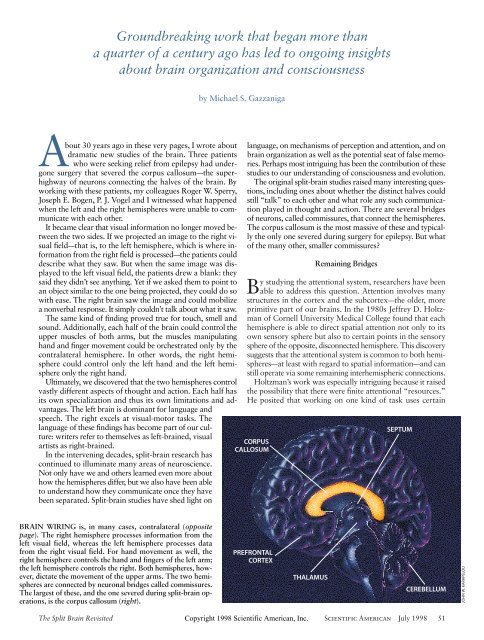The Split Brain Revisited - The University of Texas at Dallas
The Split Brain Revisited - The University of Texas at Dallas
The Split Brain Revisited - The University of Texas at Dallas
You also want an ePaper? Increase the reach of your titles
YUMPU automatically turns print PDFs into web optimized ePapers that Google loves.
Groundbreaking work th<strong>at</strong> began more than<br />
a quarter <strong>of</strong> a century ago has led to ongoing insights<br />
about brain organiz<strong>at</strong>ion and consciousness<br />
About 30 years ago in these very pages, I wrote about<br />
dram<strong>at</strong>ic new studies <strong>of</strong> the brain. Three p<strong>at</strong>ients<br />
who were seeking relief from epilepsy had undergone<br />
surgery th<strong>at</strong> severed the corpus callosum—the superhighway<br />
<strong>of</strong> neurons connecting the halves <strong>of</strong> the brain. By<br />
working with these p<strong>at</strong>ients, my colleagues Roger W. Sperry,<br />
Joseph E. Bogen, P. J. Vogel and I witnessed wh<strong>at</strong> happened<br />
when the left and the right hemispheres were unable to communic<strong>at</strong>e<br />
with each other.<br />
It became clear th<strong>at</strong> visual inform<strong>at</strong>ion no longer moved between<br />
the two sides. If we projected an image to the right visual<br />
field—th<strong>at</strong> is, to the left hemisphere, which is where inform<strong>at</strong>ion<br />
from the right field is processed—the p<strong>at</strong>ients could<br />
describe wh<strong>at</strong> they saw. But when the same image was displayed<br />
to the left visual field, the p<strong>at</strong>ients drew a blank: they<br />
said they didn’t see anything. Yet if we asked them to point to<br />
an object similar to the one being projected, they could do so<br />
with ease. <strong>The</strong> right brain saw the image and could mobilize<br />
a nonverbal response. It simply couldn’t talk about wh<strong>at</strong> it saw.<br />
<strong>The</strong> same kind <strong>of</strong> finding proved true for touch, smell and<br />
sound. Additionally, each half <strong>of</strong> the brain could control the<br />
upper muscles <strong>of</strong> both arms, but the muscles manipul<strong>at</strong>ing<br />
hand and finger movement could be orchestr<strong>at</strong>ed only by the<br />
contral<strong>at</strong>eral hemisphere. In other words, the right hemisphere<br />
could control only the left hand and the left hemisphere<br />
only the right hand.<br />
Ultim<strong>at</strong>ely, we discovered th<strong>at</strong> the two hemispheres control<br />
vastly different aspects <strong>of</strong> thought and action. Each half has<br />
its own specializ<strong>at</strong>ion and thus its own limit<strong>at</strong>ions and advantages.<br />
<strong>The</strong> left brain is dominant for language and<br />
speech. <strong>The</strong> right excels <strong>at</strong> visual-motor tasks. <strong>The</strong><br />
language <strong>of</strong> these findings has become part <strong>of</strong> our culture:<br />
writers refer to themselves as left-brained, visual<br />
artists as right-brained.<br />
In the intervening decades, split-brain research has<br />
continued to illumin<strong>at</strong>e many areas <strong>of</strong> neuroscience.<br />
Not only have we and others learned even more about<br />
how the hemispheres differ, but we also have been able<br />
to understand how they communic<strong>at</strong>e once they have<br />
been separ<strong>at</strong>ed. <strong>Split</strong>-brain studies have shed light on<br />
BRAIN WIRING is, in many cases, contral<strong>at</strong>eral (opposite<br />
page). <strong>The</strong> right hemisphere processes inform<strong>at</strong>ion from the<br />
left visual field, whereas the left hemisphere processes d<strong>at</strong>a<br />
from the right visual field. For hand movement as well, the<br />
right hemisphere controls the hand and fingers <strong>of</strong> the left arm;<br />
the left hemisphere controls the right. Both hemispheres, however,<br />
dict<strong>at</strong>e the movement <strong>of</strong> the upper arms. <strong>The</strong> two hemispheres<br />
are connected by neuronal bridges called commissures.<br />
<strong>The</strong> largest <strong>of</strong> these, and the one severed during split-brain op-<br />
by Michael S. Gazzaniga<br />
language, on mechanisms <strong>of</strong> perception and <strong>at</strong>tention, and on<br />
brain organiz<strong>at</strong>ion as well as the potential se<strong>at</strong> <strong>of</strong> false memories.<br />
Perhaps most intriguing has been the contribution <strong>of</strong> these<br />
studies to our understanding <strong>of</strong> consciousness and evolution.<br />
<strong>The</strong> original split-brain studies raised many interesting questions,<br />
including ones about whether the distinct halves could<br />
still “talk” to each other and wh<strong>at</strong> role any such communic<strong>at</strong>ion<br />
played in thought and action. <strong>The</strong>re are several bridges<br />
<strong>of</strong> neurons, called commissures, th<strong>at</strong> connect the hemispheres.<br />
<strong>The</strong> corpus callosum is the most massive <strong>of</strong> these and typically<br />
the only one severed during surgery for epilepsy. But wh<strong>at</strong><br />
<strong>of</strong> the many other, smaller commissures?<br />
Remaining Bridges<br />
By studying the <strong>at</strong>tentional system, researchers have been<br />
able to address this question. Attention involves many<br />
structures in the cortex and the subcortex—the older, more<br />
primitive part <strong>of</strong> our brains. In the 1980s Jeffrey D. Holtzman<br />
<strong>of</strong> Cornell <strong>University</strong> Medical College found th<strong>at</strong> each<br />
hemisphere is able to direct sp<strong>at</strong>ial <strong>at</strong>tention not only to its<br />
own sensory sphere but also to certain points in the sensory<br />
sphere <strong>of</strong> the opposite, disconnected hemisphere. This discovery<br />
suggests th<strong>at</strong> the <strong>at</strong>tentional system is common to both hemispheres—<strong>at</strong><br />
least with regard to sp<strong>at</strong>ial inform<strong>at</strong>ion—and can<br />
still oper<strong>at</strong>e via some remaining interhemispheric connections.<br />
Holtzman’s work was especially intriguing because it raised<br />
the possibility th<strong>at</strong> there were finite <strong>at</strong>tentional “resources.”<br />
He posited th<strong>at</strong> working on one kind <strong>of</strong> task uses certain<br />
CORPUS<br />
CALLOSUM<br />
PREFRONTAL<br />
CORTEX<br />
SEPTUM<br />
THALAMUS<br />
KARAPELOU<br />
CEREBELLUM<br />
W.<br />
er<strong>at</strong>ions, is the corpus callosum (right). JOHN<br />
<strong>The</strong> <strong>Split</strong> <strong>Brain</strong> <strong>Revisited</strong> Copyright 1998 Scientific American, Inc.<br />
Scientific American July 1998 51

















